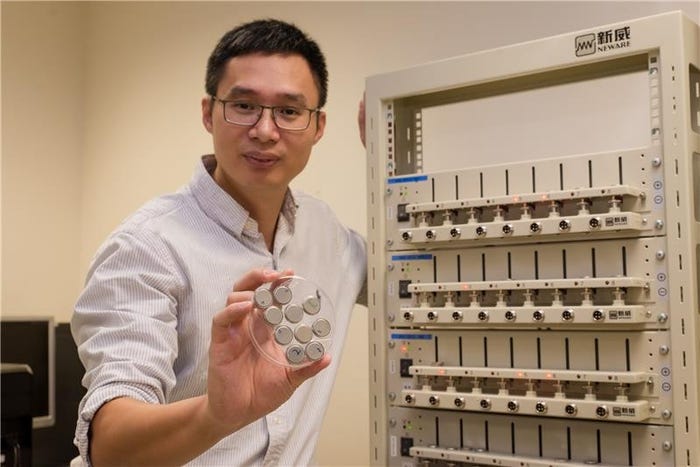New Battery Can Charge in Minutes
October 26, 2014
Scientists in Singapore have developed a new battery technology that could be recharged up to 70% in only two minutes. The potentially revolutionary technology will also have a longer lifespan that can last over 20 years.
In a news release from Nanyang Technological University, details were released about the battery that would have potential applications across a wide range of industries from electric cars to power-hungry portable medical devices and machines.
NTU's scientists developed the technology by replacing the traditional graphite used for the anode (known as the negative pole) in lithium-ion batteries with a new gel material made from titanium dioxide. Titanium dioxide is both a inexpensive and safe material that can be found in soil, and is commonly used as a food additive, as well as an absorbent of ultraviolet rays in sunscreen.
|
Xiaodong holds the quick-charging batteries. |
While the titanium dioxide is naturally found in a spherical shape, NTU scientists developed a method to turn the particles into tiny nanotubes that are a thousand times thinner than the diameter of a human hair. This tiny nanostructure is what speeds up the chemical reactions in the new battery, allowing for unprecedented recharge speeds.
Lithium-ion batteries are widely used in both implantable and non-implantable medical devices, making battery life and recharge rates a crucial component to the device's ability to be effective. With batteries expected to continue to play a role in medtech devices for the foreseeable future, plenty of focus is still being directed at improving batteries in new innovative ways.
According to Frost & Sullivan, the global market for rechargeable lithium-ion batteries is projected to be worth north of $23 billion in 2016. The extended battery life is also expected to reduce the cost of battery replacement by a significant amount, which will also help reduce the amount of waste created by disposed dead batteries.
"We can now drastically cut down the waste generated by disposed batteries, since our batteries last ten times longer than the current generation of lithium-ion batteries," said Chen Xiaodong, associate professor of materials and science engineering at NTU and inventor of the technology. "Manufacturing this new nanotube gel is very easy. Battery manufacturers will find it easy to integrate our new gel into their current production processes."
This battery research project took the NTU Singapore scientists three years to complete, as the team looks to complete a large-scale battery prototype in preparation to release the technology to the market in the next few years.
The team also believes there is still room for improvement, as they look into the power density and how it relates to the recharge speed. Ideally, the team would like to develop a battery powerful enough to power our vehicles on the road, with the ability to fully recharge in just 15 minutes.
With the next generation of lithium-ion batteries upon us, the potential impact of the technology could be truly revolutionary. From implantable devices and wearable technology, to electric cars on the road, the benefits of these next-gen batteries could be felt by almost everyone.
Refresh your medical device industry knowledge at MD&M Minneapolis, October 29-30, 2014. |
Kristopher Sturgis is a contributor to Qmed and MPMN.
Like what you're reading? Subscribe to our daily e-newsletter.
About the Author(s)
You May Also Like


